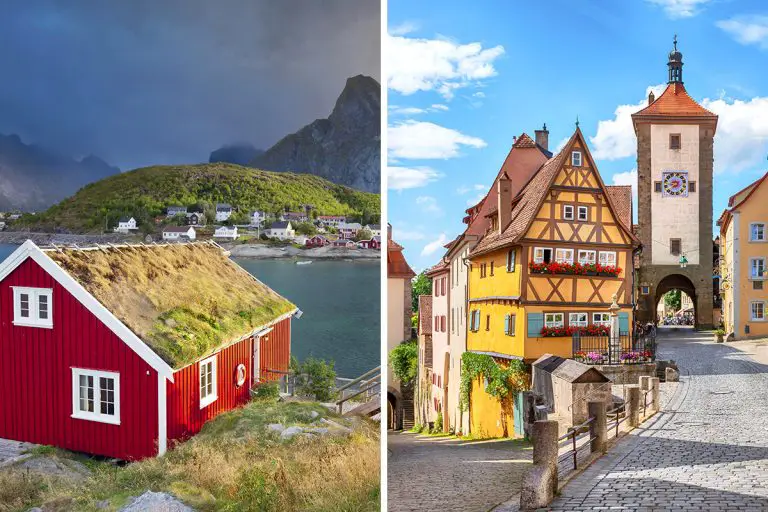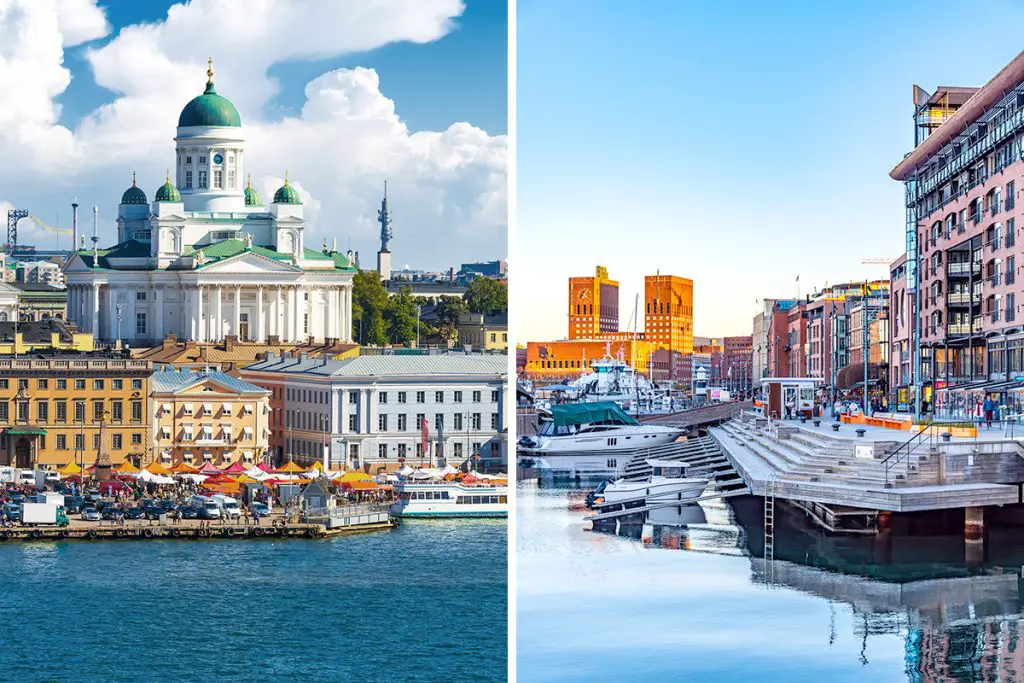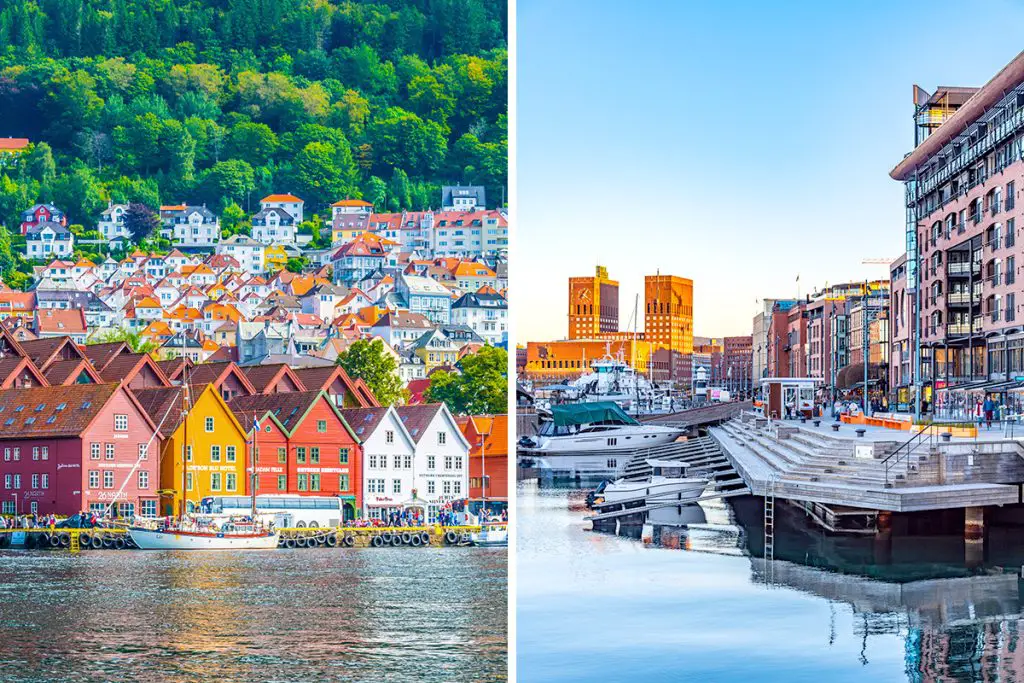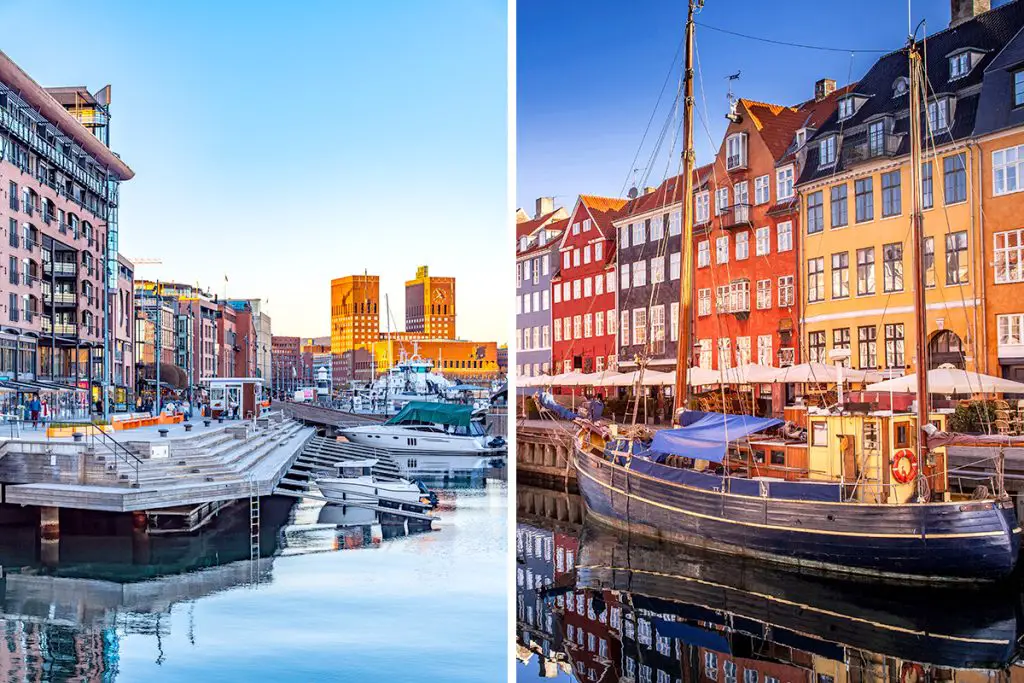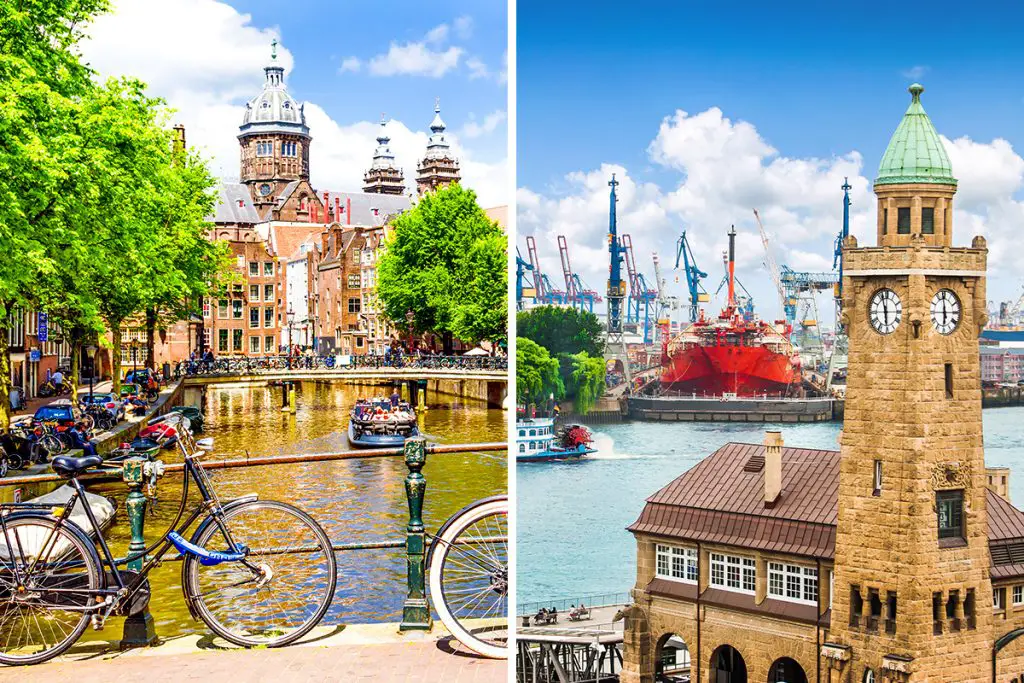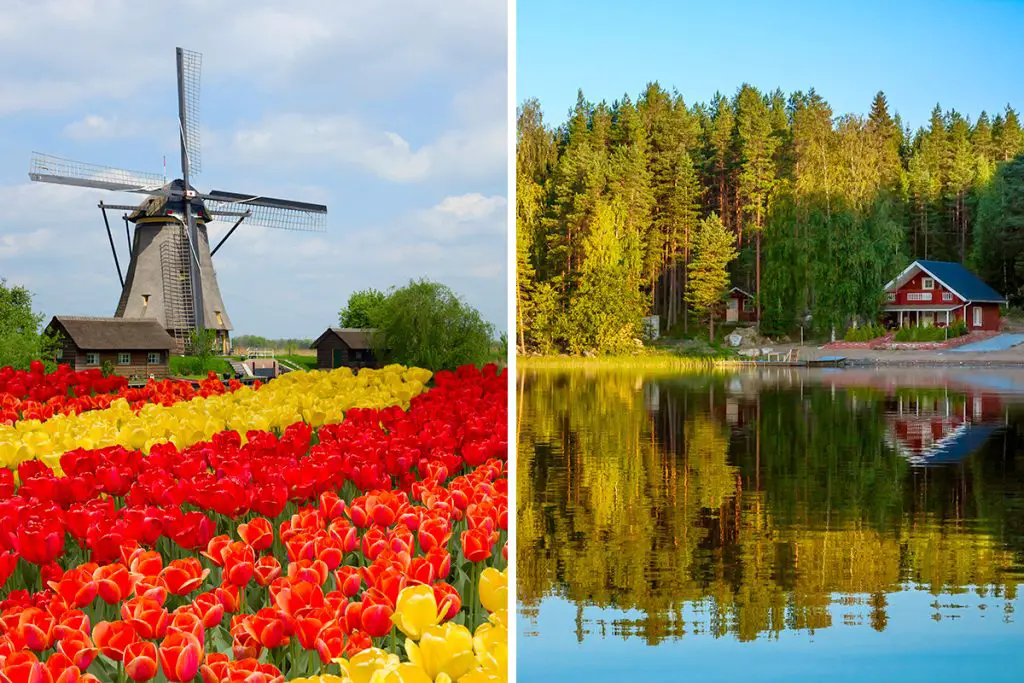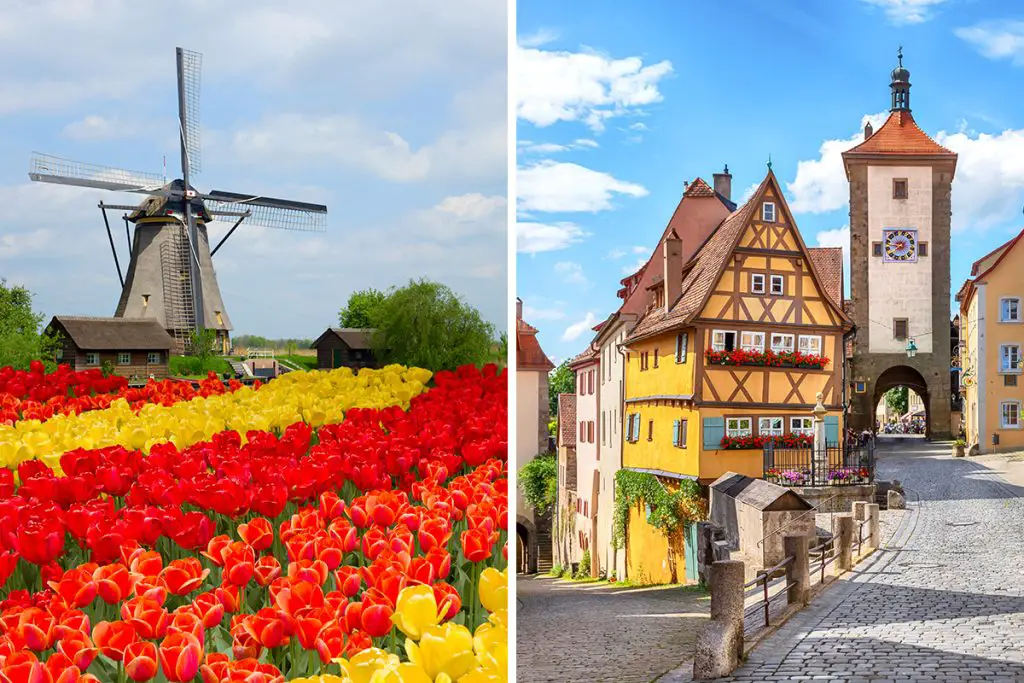Norway and Germany, each with its distinct charm, beckon travelers with open arms. The whispers of Norway’s untouched wilderness might pull at your heartstrings, while the rhythm of Germany’s vibrant culture could set your feet tapping. Ready to explore the core of these two European gems? Your journey begins here!
History & Culture
When you think about exploring the pages of history and soaking in the culture, Norway and Germany stand as epitomes of rich heritage. Each country cradles a unique story in its heart, waiting to be unraveled.
Norway’s history is like an exciting book with many chapters. It talks about fierce Vikings who sailed far and wide. The stories of their bravery and explorations are something that Norwegians are proud of. Even today, the spirit of adventure runs deep in Norway’s heart.
The culture here appreciates the beauty of nature and outdoor activities. The tradition of ‘friluftsliv’, or open-air living, is something very special in Norway. It tells you a lot about how much Norwegians love their beautiful landscapes.
Germany’s past is a mix of many colors. It has seen times of kings and queens, wars and peace. Over centuries, Germany has grown into a place where tradition meets modernity.
The culture here cherishes its historical roots while embracing the new. You’ll find age-old traditions celebrated with gusto alongside modern-day festivities. The love for music, art, and literature is evident in every corner of Germany.
Comparing Norway and Germany is like looking at two beautiful paintings, each unique and fascinating in its own way. The serene simplicity of Norway’s cultural canvas contrasts with the dynamic and colorful palette of Germany’s historical and cultural landscape.
Every tradition and every historical monument in these countries is like a brushstroke that tells a part of their story.
In Norway, you’ll find a calm and peaceful lifestyle, with a deep respect for nature and a love for outdoor adventures. The cultural vibe is more laid back, and life here seems to move at a slower pace, allowing you to soak in the serene beauty all around.
In Germany, the cultural rhythm is faster, filled with lively festivals, music that resonates through the streets, and a vibrant social scene. The historical vibe is palpable, with stories whispering through the ancient stone of its many monuments.
In conclusion, the choice between experiencing the calm, nature-infused culture of Norway or diving into the lively, history-rich atmosphere of Germany is a captivating one. Each destination holds a treasure trove of experiences waiting to be discovered. Your appreciation for history, culture, and the pace of life may tip the scales in favor of one over the other.
Attractions & Activities
Embarking on a journey to either Norway or Germany unlocks a myriad of attractions and activities that offer a glimpse into the heart of each destination. The natural wonders of Norway beckon with a promise of adventure, while the architectural marvels of Germany invite a deep dive into historical narratives. Here’s a closer look at what each has to offer.
Norway is a haven for those who have a thirst for outdoor exploration. The majestic fjords such as Geirangerfjord and Nærøyfjord offer an extraordinary playground for kayaking, hiking, and sightseeing cruises.
A journey along the scenic Flåm Railway provides panoramic views of the Norwegian countryside, whisking you through verdant landscapes and past roaring waterfalls. For a taste of the celestial, catching a glimpse of the Northern Lights in Tromsø during the winter months is an experience etched in magic.
On the flip side, Germany teems with architectural and historical attractions. The towering Cologne Cathedral, with its gothic spires reaching towards the sky, or the historic charm of Heidelberg Castle, offer a journey through time.
Neuschwanstein Castle, seemingly plucked from a fairy tale, stands amidst the lush Bavarian Alps, showcasing the romantic architectural style of 19th-century Germany. For a dive into history, a guided tour through the remnants of the Berlin Wall provides a poignant reminder of Germany’s past.
The pace and style of activities in both countries cater to different kinds of adventure-seekers. In Norway, the call of the wild and the lure of natural splendors provide a tranquil yet exhilarating escape. In Germany, the cobblestone streets lined with historic structures offer a more urban exploration, filled with tales of bygone eras.
In summary, whether it’s the natural allure of Norway’s expansive landscapes or the historic tapestry of Germany’s urban centers, both destinations offer a rich array of attractions and activities. The choice hinges on whether your heart yearns for the quiet whisper of nature or the resonant echo of history.
Beaches
The allure of sun, sand, and surf is a timeless one, yet the beaches of Norway and Germany offer distinct experiences. Whether it’s the rugged coastline of Norway or the more tranquil shores of Germany, both destinations offer a unique beach escape.
Norway’s coastline is a dramatic display of nature’s grandeur. The beaches here, like Kvalvika Beach, are nestled amidst towering cliffs and rocky landscapes. The water temperatures are chilly, often hovering around 12°C (53.6°F), and the waves can be quite vigorous.
The rugged beauty and solitude found on Norway’s shores are unparalleled, offering a serene yet wild beach experience.
On the other hand, Germany’s beaches along the Baltic Sea, like those at Rügen Island, provide a gentler retreat. The waters are calmer with temperatures around 17°C (62.6°F) during summer, and the sandy shores are more inviting for a leisurely stroll.
The backdrop of quaint villages and the distant hum of seafaring vessels add a picturesque charm to the German beach experience.
The stark contrast between the wild, untamed beaches of Norway and the calm, picturesque shores of Germany provides a distinct beach experience. While Norway’s beaches offer a raw, natural escape, Germany’s shores welcome with a gentle, serene embrace.
Summarizing, the distinctive beach experiences in Norway and Germany are reflective of their inherent natural beauty and geographical landscapes. Your preference between the wild, rugged beaches of Norway, and the calm, scenic beaches of Germany may just be a deciding factor in your next travel endeavor.
Eating, Drinking & Nightlife
Tantalizing the taste buds and diving into the night, both Norway and Germany offer a unique spectrum of flavors and nocturnal adventures. The culinary journey and evening escapades in these countries paint a vivid picture of their lifestyle and traditions. Let’s unravel the culinary and nocturnal tapestry awaiting in both lands.
Norwegian cuisine takes a simple yet hearty approach to food. Dishes like Klippfisk (dried and salted cod) and Raspeballer (potato dumplings) reflect Norway’s maritime heritage and agricultural tradition. The emphasis is on fresh, locally sourced ingredients, providing a wholesome dining experience.
In Germany, the food journey is hearty as well, but with a different zest. Savory delights like Bratwurst (grilled sausage) and Sauerkraut (fermented cabbage) tickle the palate, while the sweet tooth is satisfied by treats like Black Forest Cake. The culinary scene is diverse, reflecting the various regional cultures within Germany.
When it comes to drinking, the traditional aquavit of Norway is a must-try. This distilled spirit, infused with herbs and spices, reflects the country’s love for the old and authentic. On the other hand, Germany, with its renowned beer culture, invites you to experience the camaraderie of a Biergarten (beer garden) with a chilled pint of locally brewed goodness.
The nightlife in Norway is relatively low-key, with cozy bars and occasional live music venues. It’s a tranquil way to wind down the day under the midnight sun or the northern lights. Germany, however, pulsates with a lively night scene. From bustling beer halls in Munich to cutting-edge clubs in Berlin, the night holds a promise of lively conversations and dance floor escapades.
In conclusion, the gastronomic journey and nightlife in Norway and Germany are as diverse as their landscapes. From the wholesome simplicity of Norwegian dishes and tranquil nights to the hearty German cuisine and vibrant nocturnal escapades, the cultural nuances are delightful to explore.
Shopping
The hustle of marketplaces and the allure of unique finds make shopping an exciting venture in both Norway and Germany. Each destination presents a different shopping atmosphere, filled with treasures waiting to be discovered.
In Norway, shopping is a laid-back affair. You might find yourself wandering through quaint boutiques offering handcrafted goods, like traditional Norwegian sweaters or delicate glasswork. The emphasis on quality and craftsmanship is evident, offering a glimpse into the Norwegian ethos of simplicity and elegance.
Germany, on the other hand, is a haven for those who appreciate both tradition and modernity in their shopping spree. From the bustling markets selling handcrafted trinkets and age-old German crafts to sleek boutiques showcasing modern design and fashion, the variety is enthralling.
Moreover, Germany is home to a plethora of shopping streets like the Zeil in Frankfurt or Schildergasse in Cologne, bustling with a mixture of international and local brands. The juxtaposition of traditional markets and contemporary retail spaces makes shopping in Germany a rich experience.
The contrast between Norway’s calm, quality-centered shopping ambiance, and Germany’s vibrant, diverse shopping scene highlights the unique charm of each destination.
In summary, whether you’re enamored by the tranquil pursuit of handcrafted treasures in Norway or the lively bustle of Germany’s modern marketplaces, the shopping experience in both lands promises a delightful exploration of their cultural fabric.
Accommodation
A good place to rest is a cornerstone of any memorable travel experience. Both Norway and Germany boast a range of accommodations that cater to different tastes and preferences, each offering a unique peek into the local culture and landscape.
In Norway, the lodging experience often comes with a scenic view. Whether it’s a cozy wooden cabin nestled amidst the fjords or a modern hotel overlooking the bustling cityscape of Oslo, the connection to nature is ever-present. Some unique stays include historical hotels or mountain lodges, providing a rustic yet comfortable retreat.
Germany, on the other hand, offers a blend of the historic and the modern in its accommodations. From centuries-old castles converted into luxurious hotels to sleek, contemporary urban lodges, the options are vast. The hospitality here often reflects a rich tradition, with a touch of modern amenities for added comfort.
In both countries, you’ll also find a range of hostels and guesthouses that offer a more communal or budget-friendly stay. The vibe in these places often mirrors the local culture, providing a more authentic experience.
In essence, whether it’s the tranquil embrace of Norway’s scenic lodges or the historical richness of Germany’s diverse accommodations, both countries promise a comfortable and enriching stay.
Family-Friendliness & Children’s Activities
Family travels create memories that last a lifetime, and both Norway and Germany are splendid playgrounds for children and adults alike. The range of family-friendly activities and attractions in these countries can turn any vacation into an adventure filled with discovery and bonding.
Norway is a natural wonderland that offers plenty of outdoor activities suitable for families. From exploring the majestic fjords on a family-friendly cruise to going on nature trails in the national parks, there’s a plethora of experiences waiting for young explorers.
Germany, too, is rich with experiences that cater to the young and the young at heart. The numerous fairy tale castles scattered across the country can make any child feel like royalty. Educational yet fun attractions like the Deutsches Museum in Munich offer interactive exhibits that ignite curiosity and learning.
Summarizing, both Norway and Germany lay out a banquet of family-friendly activities and attractions. The choice between a nature-oriented adventure in Norway or a fairy tale come to life in Germany depends on the whims of imagination in your family.
Getting There & Getting Around
The journey begins with a step, but how you take that step and navigate through either Norway or Germany can shape the rhythm of your adventure. From arrival to exploration, the ease of movement is a key part of the travel tapestry.
Getting to Norway is often via air, with major international airports like Oslo Gardermoen Airport serving as primary gateways. The country’s location on the northern fringe of Europe makes flights a convenient choice.
On the other hand, Germany, being centrally located in Europe, is accessible by flights, trains, and even by road. Major airports include Frankfurt Airport and Munich Airport, while the extensive road and rail networks provide easy connections from neighboring countries.
Once in Norway, getting around might be a bit slower yet scenic. The country’s rugged terrain makes traveling by boat or ferry common, especially along the iconic fjords. However, there’s also a well-maintained network of buses and trains that traverse the picturesque landscapes, covering distances from a few kilometers to over 500 kilometers (about 3 to 311 miles).
In Germany, the transport infrastructure is highly developed. Efficient train systems like the Deutsche Bahn, along with an extensive network of buses and trams, make getting around both cities and countryside swift and convenient. The Autobahn, Germany’s famed highway system, also provides a speedy and scenic drive through the country’s diverse landscapes.
In summary, the journey to and through Norway and Germany offers contrasting experiences. While Norway invites a slower, scenic exploration, Germany provides a fast, efficient means to traverse its rich and varied landscapes. Your adventure tempo sets the pace, be it the tranquil trails of Norway or the swift pathways of Germany.
Weather
Weather plays a pivotal role in shaping your travel experiences. The climate in both Norway and Germany varies significantly, each offering a unique ambiance throughout the year. Let’s delve into the atmospheric demeanor of these two captivating destinations.
Norway, perched up north, experiences colder temperatures year-round. The winter months from November to March can be quite chilly with temperatures often plunging below 0°C (32°F), especially in inland areas.
Meanwhile, the coastal regions remain milder. The summer months from June to August are pleasant, with temperatures hovering around 13-22°C (55-72°F), providing a cool respite for outdoor explorations.
Germany enjoys a temperate climate with distinct seasons. The winters, spanning December to February, see temperatures drop to around 0°C (32°F) but rarely go below -10°C (14°F). Come summer, from June to August, the mercury rises to a comfortable range of 20-30°C (68-86°F), creating a warm and inviting atmosphere for a variety of activities.
Spring and autumn in both countries offer moderate temperatures, though they tend to be cooler in Norway compared to Germany. These seasons provide a sweet spot for those who prefer mild weather for their adventures.
Rainfall is another factor to consider. Norway tends to receive more precipitation, especially along the coast, while Germany has a more balanced spread of rainfall throughout the year.
In summary, the contrasting climates between Norway’s cool embrace and Germany’s temperate charm provide varied backdrops for your travel escapades. Your preference for a cool, tranquil haven or a warm, lively atmosphere might steer your choice between these two fascinating destinations.
Safety
Safety is a paramount concern when planning your travels. Both Norway and Germany are considered to be quite safe, with low crime rates and well-established systems in place to ensure public security.
In Norway, the crime rates are among the lowest in the world. The peaceful atmosphere and strong community bonds contribute to the overall safety of this country. Similarly, Germany boasts low crime rates, with efficient law enforcement agencies ensuring public safety.
Beyond crime, it’s essential to consider other safety aspects like road conditions and emergency services. Both countries have well-maintained roads and robust emergency response systems, ensuring prompt assistance when needed.
In Norway, one unique safety concern could be its challenging weather conditions, especially during winter, which requires adequate preparation for those venturing outdoors. In Germany, the well-organized urban infrastructure minimizes many potential hazards, making it easy to navigate and explore.
Summarizing, both Norway and Germany uphold high safety standards, making them reliable choices for worry-free travel. The peaceful and orderly environments in both countries contribute to their appeal as safe and welcoming destinations.
Cost
Travel expenses are a key factor in planning your journey. The cost of living and traveling in Norway and Germany varies, and understanding these differences can help budget your adventure effectively.
Norway is known for its high living costs. Dining out, for example, can be quite expensive, with a meal at a mid-range restaurant costing around 200-300 NOK (approximately 18-27 USD).
Accommodations, too, are on the higher end, with lodging prices reflecting the country’s high standard of living. Transportation costs, whether it’s public transport or car rentals, are also relatively high.
Germany, on the other hand, offers a more moderate cost of living. A similar meal in a mid-range restaurant might cost around 10-20 EUR (approximately 11-21 USD).
The range of accommodation options from budget hostels to luxury hotels caters to a wider array of budgets. Transportation costs are also more budget-friendly, making getting around and exploring quite affordable.
The cost disparity extends to attractions and activities as well. Entry fees to various attractions and the cost of engaging in recreational activities tend to be higher in Norway compared to Germany.
In conclusion, the cost of traveling in Norway is relatively higher compared to Germany. Your budget may stretch further in Germany, allowing for a broader range of experiences, while in Norway, the pristine natural beauty and high-quality services reflect the higher price point.
Which Is Better – Norway or Germany?
These European treasures, though geographically close, offer a world of differences that cater to varied traveler desires. Here’s a succinct reflection on the comparison of these two destinations across various facets of travel, to help steer your choice.
The historical and cultural dive in both nations unveils a rich tapestry of narratives. Norway’s serene simplicity and profound connection to nature weave through its history and traditions. Germany, on the other hand, presents a vibrant blend of the old and the new, where each historical monument and tradition tells tales of its rich past.
When it comes to attractions and activities, Norway’s pristine landscapes beckon for outdoor exploration, offering a tranquil retreat into nature’s wonders. Germany’s architectural marvels and historic sites provide a robust avenue for urban exploration and a peek into fairy tales with its picturesque castles.
A sojourn to the beaches reveals the wild, rugged beauty of Norway’s coastline against the calm, serene shores of Germany. The contrasting experiences offer a peaceful solitude on the Norwegian shores or a gentle, scenic retreat on Germany’s beaches.
The culinary and nocturnal scene unveils another layer of contrast. Norway offers a simple, hearty fare and a tranquil nightlife, resonating with its calm lifestyle. Germany buzzes with a lively night scene and a hearty, diverse culinary journey that tantalizes the taste buds.
Shopping in Norway leans towards quality craftsmanship and a calm ambiance, while Germany’s bustling markets and modern retail spaces offer a vibrant shopping scene. The accommodation spectrum ranges from scenic lodges in Norway to historic, luxurious stays in Germany, each providing a unique backdrop to your adventure.
Family-friendliness and children’s activities, ease of getting there and around, the weather, safety, and cost further differentiate these destinations.
Norway’s nature-centered adventures, safety, and serene lifestyle may appeal to those seeking tranquility and natural beauty, albeit at a higher cost. Germany, with its moderate climate, rich history, more budget-friendly options, and family-centered activities, provides a wholesome, lively, and educational escapade.
In summation, your choice between Norway and Germany hinges on your preferences. For a tranquil retreat into nature’s embrace, Norway awaits. However, if a lively, educational, and culturally rich excursion appeals to you, Germany beckons with open arms. Each destination, with its unique offerings, promises a journey filled with enriching experiences and cherished memories.

